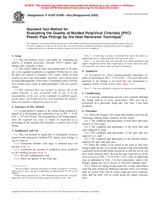We need your consent to use the individual data so that you can see information about your interests, among other things. Click "OK" to give your consent.
ASTM F610/F610M-00a(2005)
Standard Test Method for Evaluating the Quality of Molded Poly(Vinyl Chloride) (PVC) Plastic Pipe Fittings by the Heat Reversion Technique (Includes all amendments And changes 12/31/2010).
Automatically translated name:
Standard Test Method for Evaluating the Quality of Molded Poly(Vinyl Chloride) (PVC) Plastic Pipe Fittings by the Heat Reversion Technique
STANDARD published on 1.8.2005
The information about the standard:
Designation standards: ASTM F610/F610M-00a(2005)
Note: WITHDRAWN
Publication date standards: 1.8.2005
SKU: NS-55899
The number of pages: 4
Approximate weight : 12 g (0.03 lbs)
Country: American technical standard
Category: Technical standards ASTM
Annotation of standard text ASTM F610/F610M-00a(2005) :
Keywords:
evaluating, fittings, plastic, PVC, quality, ICS Number Code 23.040.20 (Plastic pipes), 23.040.45 (Plastic fittings)
Additional information
| Significance and Use |
|
This test method is applicable to distinguish between properly and improperly molded PVC plastic pipe fittings. It can be used to: 3.1.1 Determine whether cold slugs or unfused areas are present (Note 1), 3.1.2 Determine the amount of molded-in stress produced by the molding process (Note 2), 3.1.3 Reveal contamination, and 3.1.4 Show the quality of the weld line. Note 1—A cold slug is a piece of material that enters the mold at a significantly lower temperature than the rest of the mass. Note 2—A stress-free part will generally have better properties and higher strength than those with a high degree of stress. Stress-free parts will generally react better when exposed to chemicals. |
| 1. Scope |
|
1.1 This test method covers a procedure for evaluating the quality of molded poly(vinyl chloride) (PVC) plastic pipe fittings after exposure to heat. 1.2 The values stated in either inch-pound units or SI units are to be regarded separately as standard. Within the text, the SI units are shown in brackets. The values stated in each system are not exact equivalents; therefore, each system must be used independently of the other. Combining values from the two systems may result in nonconformance with the specification. 1.3 This standard does not purport to address all of the safety problems, if any, associated with its use. It is the responsibility of the user of this standard to establish appropriate safety and health practices and determine the applicability of regulatory limitations prior to use. |
We recommend:
Technical standards updating
Do you want to make sure you use only the valid technical standards?
We can offer you a solution which will provide you a monthly overview concerning the updating of standards which you use.
Would you like to know more? Look at this page.




 Cookies
Cookies
